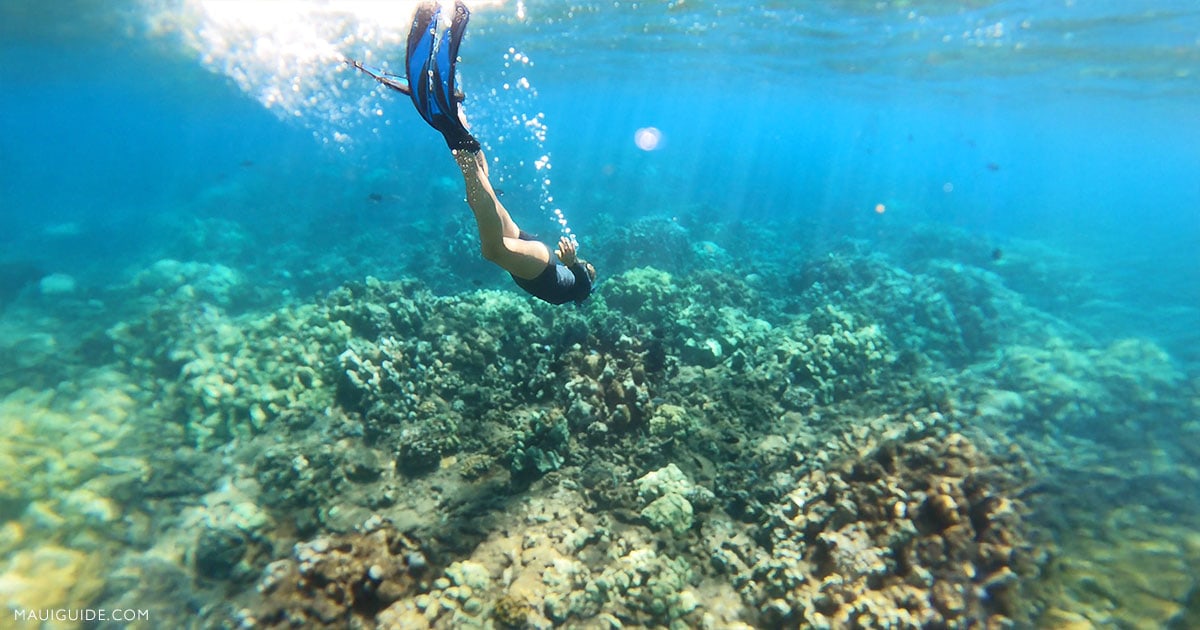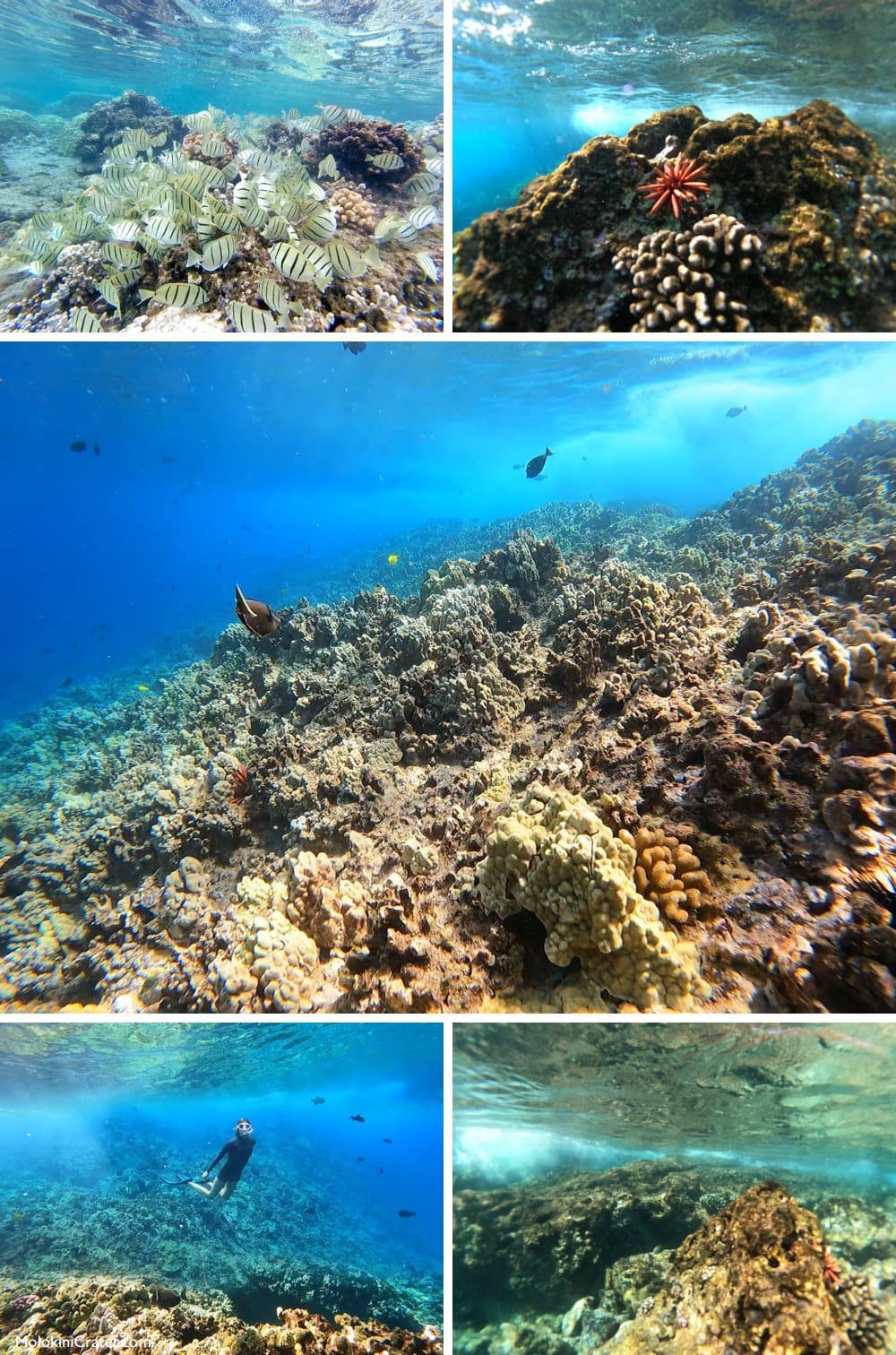Snorkeling around Maui can feel completely different from one spot to the next: from quiet, fish filled coves to open ocean craters where the bottom drops away to a deep blue bowl. Knowing what to expect, and where to go, helps you enjoy more and worry less.


Shallow Reefs Close to Shore
Most people fall in love with Maui snorkeling in the shallows. Just a short swim from many beaches, you’ll find rocky lava outcrops and coral heads that work like tiny cities for reef fish.
These reefs are full of action. You might see:
- Butterflyfish, triggerfish, parrotfish, Moorish idols, and clouds of striped damselfish
- Hawaiian green sea turtles (honu) cruising between coral heads or resting on the bottom
- Eels peeking from cracks, small octopus changing color, and the occasional ray gliding past
Because the water is relatively shallow, light reaches the bottom easily, which makes the fish/coral look extra bright and colorful and keeps snorkeling from feeling intimidating. This is where beginners, kids, and anyone who just wants a gentle float will be the happiest.
Some of these reefs sit right in front of easy access beaches. Others are tucked around rocky points so you will swim a little farther from shore but still keep land in clear view the whole time.


Life Out In The Blue
Step away from the shelter of the reef and things shift. In open water, color matters less than survival. Fish that live away from rocky cover rely on speed, sharp senses, and the ability to travel long distances.
Different species solve this in different ways. Large predators such as oceanic white tip and tiger sharks are built to fend for themselves. They move alone, cover a lot of ground, and are perfectly tuned to find food in what can look like an empty blue desert.
Smaller fish have to improvise. Without cracks and coral to hide in they gather into schools, thousands of bodies moving as one spinning shape. Inside that swirl an individual fish becomes harder to pick out, which makes hunting more complicated for anything that might want a snack.
Some fish take this idea a step further. Juvenile jacks, for example, will often shadow a larger fish, sticking so close that they seem attached to its side. The bigger fish does not gain much from this, but the little jack gets both protection and access to bits of food when its “bodyguard” feeds. Some species live like this for their entire lives. Others tag along only while they are small and break away once they are fast and strong enough to manage on their own.
Wherever you look, from the coral line near shore to deeper open water, there is life adapting to whatever the ocean throws at it.


Boat Snorkel Trips
While you can see plenty from shore, some of Maui’s most famous snorkel sites require a boat. If you want something easy, organized, and family friendly, Four Winds is one of the top choices.
Four Winds operates out of Maʻalaea Harbor and focuses on classic snorkel destinations, with crew who do this every day and know how to read Maui’s shifting weather and swell. On board you can expect gear, instruction, flotation, food, and a relaxed, social feel rather than a rushed checklist of stops.
Their most popular trip is the morning tour to Molokini Crater, a crescent shaped volcanic crater offshore from South Maui. The clear water here often feels more like floating in air than swimming. Coral slopes gently downward, schools of fish move along the crater wall, and visibility can stretch well beyond what you might see from the beach.

When conditions set up differently, Four Winds will often head to Coral Gardens, a sheltered stretch of reef along the Pali coast. This area is known for healthy coral formations, friendly reef fish, and frequent turtle sightings.
For guests who want to go a little deeper, Four Winds offers a SNUBA option on some trips, a hybrid between snorkeling and scuba that keeps your air on a raft at the surface. You breathe through a long hose and can explore below the casual snorkel crowd without the full commitment of a scuba course.
If you like the idea of a one stop, show up and relax style adventure instead of figuring out tides, parking, and currents on your own, this kind of boat trip is a strong fit.

Favorite Snorkel Spots Around Maui
You could spend weeks exploring Maui’s coastline, but a few locations come up again and again for good reason.
- Molokini Crater – Best reached by boat tours like Four Winds. Clear water, dramatic underwater slopes, and a huge variety of fish life make this a bucket list stop.
- Coral Gardens – Often used as a backup or alternative to Molokini on boat trips, this reef hugs a steep coastline and usually offers calm water with lots of coral heads and turtles.
- Olowalu Reef – An older, wide reef system along West Maui, accessible both by shore and by some tours. You will find coral “corridors” and plenty of room to explore at your own pace.
- Honolua Bay – A marine conservation district on the far north side of West Maui. In the right season, when the bay is calm, the outer reef fills with fish and coral and the surface is dotted with snorkelers.
- Black Rock – A lava point at the end of Kaʻanapali Beach, popular for both snorkeling and cliff jumping. The reef hugs the rock and is a good place to see turtles and schooling fish without going far from shore.
- Turtle Town (Maluaka Beach) – A loose name used for several turtle friendly spots around South Maui. Many snorkelers meet honu here in gentle conditions with sand channels between coral heads.


Staying Safe In The Water
Snorkeling around Maui is generally mellow, but the ocean always deserves respect. A few habits make a big difference.
Before you get in, run through a quick checklist:
- Look at the surface. Whitecaps, strong currents, or waves breaking on rocks are all signs to choose another spot.
- Watch other swimmers. If nobody else is in the water, ask yourself why. If locals are getting out, follow their lead.
- Use reef safe sunscreen or wear a long sleeve rash guard and leggings to protect both your skin and the reef.
- Use gear that fits. A leaky mask or loose fins will turn a peaceful float into a frustrating one. Stay away from the full face masks!
Once you’re in:
- Swim with a buddy and stay in sight of each other.
- Stay aware of your distance from shore and where you entered, especially if you are drifting with a current.
- Float or gently kick rather than standing on coral, which is alive, sharp and fragile.
- Give turtles and other wildlife plenty of room. Honu are protected, and crowding them is stressful for the animal and can be a problem for you if a ranger is nearby.

With a little awareness and the right expectations, snorkeling around Maui becomes less of a question mark and more of a gentle, memorable part of your trip.




